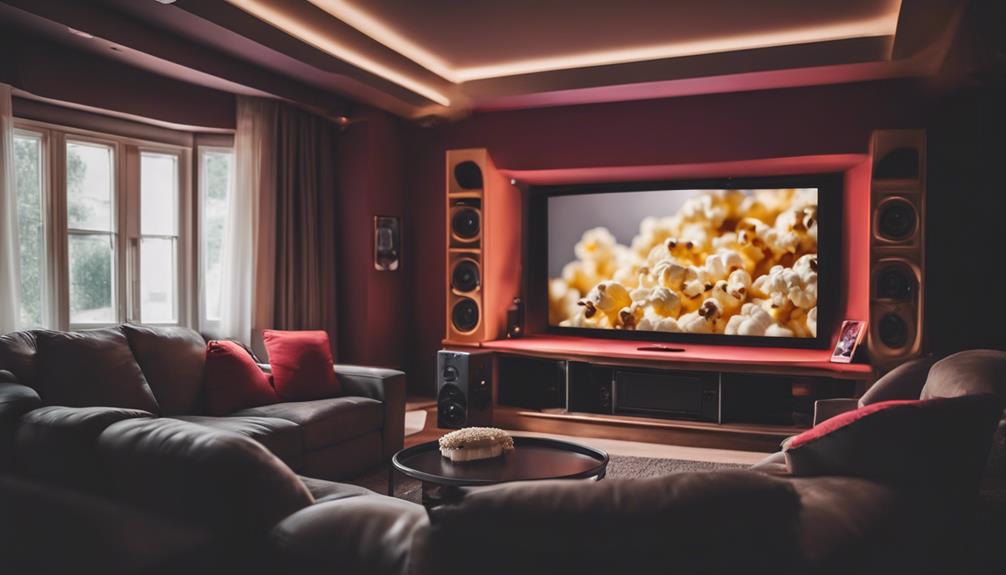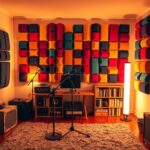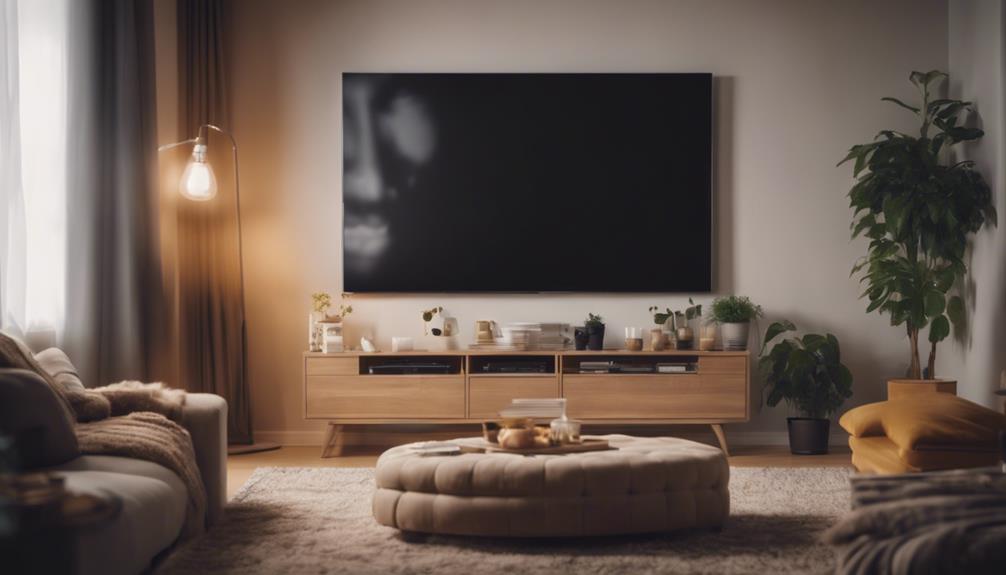To soundproof your home cinema, start by understanding sound waves and their behaviors. Use dense drywall and mass-loaded vinyl to absorb noise effectively. Incorporate acoustic panels to manage mid and high frequencies, while bass traps in corners can enhance clarity by controlling low frequencies. Consider techniques like resilient channels for decoupling your walls. Seal gaps with acoustic caulk to prevent leakage, and choose heavy curtains and rugs to dampen sound. By combining these techniques and materials, you can create an immersive audio experience. Discover more strategies tailored for your specific setup that can elevate your cinema sound quality.
Key Takeaways
- Implement damping, adding mass, and decoupling techniques to effectively reduce sound transmission in your home cinema.
- Use dense drywall, mass-loaded vinyl, and acoustic panels to absorb sound and minimize echo.
- Consider resilient channels and double wall systems to decouple structures and disrupt sound paths.
- Incorporate bass traps in corners to manage low-frequency sounds and enhance overall audio clarity.
Understanding Sound Waves
Sound waves constantly travel through various mediums, compressing and expanding air particles as they carry energy to your ears.
You experience two primary types of sound: airborne sound, which travels through the air, and structure-borne sound, which moves through solid materials. Low-frequency sounds can penetrate walls more easily, causing vibrations that can disrupt your home cinema experience. In contrast, high and mid-range frequencies are often absorbed by materials like drywall, making them less intrusive.
To measure how well materials block sound, the Sound Transmission Class (STC) rating comes into play. For a home theater, an STC rating of 55-60 is recommended to guarantee effective soundproofing.
Key principles in understanding sound waves include damping, which reduces the transfer of vibrations, and adding mass to materials, enhancing sound absorption. You might also consider decoupling techniques to interrupt the sound wave's path between surfaces, further improving your soundproofing efforts.
Ultimately, grasping these concepts about sound waves will empower you to create an ideal environment for your home cinema, where the audio quality meets your expectations without unwanted interruptions.
Soundproofing Materials

When it comes to creating a quiet home cinema, choosing the right soundproofing materials is crucial for achieving ideal audio quality. Here are some popular options to take into account:
| Soundproofing Material | Benefits | Ideal Use |
|---|---|---|
| Dense Drywall | Absorbs up to 40 decibels of sound | Walls and ceilings |
| Mass-Loaded Vinyl | Provides additional sound barriers | Ducts and pipes |
| Acoustic Panels | Absorbs sound waves, reduces echo | Walls and corners |
| Resilient Channels | Decouples drywall, minimizing sound transmission | Wall assembly |
| Quiet Batt® Soundproofing Insulation | Offers soundproofing and thermal benefits | Walls and ceilings |
These soundproofing materials enhance soundproofing effectiveness in your home theater. Dense drywall and mass-loaded vinyl can greatly reduce noise from outside or between rooms. Acoustic panels improve room acoustics by managing sound waves, while resilient channels and sound isolation clips effectively decouple your drywall, minimizing structure-borne sound transmission. Investing in high-quality options like Quiet Batt® Soundproofing Insulation guarantees efficient noise control and thermal comfort, making your cinema experience more enjoyable.
Effective Techniques

To achieve ideal soundproofing in your home cinema, employing effective techniques like decoupling and adding mass to your walls can make a significant difference.
Start by reinforcing your wall system with additional layers of drywall or mass-loaded vinyl (MLV). These materials not only enhance soundproofing but can absorb sound waves, reducing noise by up to 40 decibels.
Next, consider filling wall cavities with soundproofing insulation such as mineral wool or fiberglass. This will help improve your room's STC rating, which measures the effectiveness of soundproofing systems.
Additionally, adding acoustic panels and soft furnishings, like thick carpets and heavy curtains, effectively absorbs mid-range and high-frequency sounds, further enhancing your home theater's acoustics.
Don't overlook windows and doors—upgrading to double glazing and solid core designs minimizes noise leakage, addressing common weak points in soundproofing.
By combining these techniques and materials, you can create a soundproof home theater that allows you to enjoy your favorite films without disturbances from the outside world.
With the right approach, you'll transform your space into an immersive cinematic experience.
Decoupling Methods

When you're soundproofing your home cinema, decoupling methods play an essential role in enhancing sound isolation.
Techniques like resilient channels, double wall systems, and floating ceilings can effectively minimize noise transmission.
Resilient Channels Benefits
Resilient channels offer an effective way to decouple drywall from wall studs, markedly reducing sound transmission in your home cinema.
By installing these metal strips between the drywall and the studs, you create a barrier that minimizes the passage of sound waves, especially low-frequency noise that can be particularly troublesome.
This decoupling method can considerably enhance your wall's Sound Transmission Class (STC) rating by up to 10 points, improving your overall soundproofing effectiveness.
One of the key advantages of resilient channels is their ability to provide substantial sound isolation benefits without requiring extensive renovations.
They're a cost-effective solution, allowing you to upgrade your acoustic performance with minimal alterations to your existing structure.
However, it's crucial to install them correctly—make sure they're positioned perpendicular to the studs and spaced properly for maximum impact.
Double Wall Systems
Double wall systems provide an advanced way to enhance sound isolation in your home cinema by creating a decoupled structure that greatly reduces sound transmission. By constructing two separate walls with a gap in between, you disrupt vibration transfer, especially effective for low-frequency noise reduction.
To maximize soundproofing capabilities, consider using resilient channels or sound isolation clips, which add resilience to the wall assembly. Filling the cavity with high-density insulation, such as acoustic mineral wool, further absorbs sound energy, enhancing the overall performance.
Here's a quick overview of the benefits of double wall systems:
| Feature | Benefit | Impact on Home Theaters |
|---|---|---|
| Decoupled Structure | Reduces sound transmission | Improved sound isolation |
| Air Gap | Disrupts vibration transfer | Effective low-frequency noise reduction |
| Resilient Channels | Adds resilience | Enhanced soundproofing capabilities |
| High-Density Insulation | Absorbs sound energy | Superior sound quality |
| STC Ratings | Exceeds 60 | Ideal for home theaters |
Floating Ceiling Techniques
Floating ceilings effectively decouple your home cinema's ceiling from the building structure, greatly reducing sound transmission and enhancing your audio experience.
By creating a gap between the ceiling and the joists, you minimize vibrations that carry sound energy. This technique often utilizes resilient channels or sound isolation clips to attach drywall, allowing for flexibility that absorbs sound energy and prevents noise transfer.
For ideal sound isolation, consider adding a layer of mass-loaded vinyl (MLV) between the drywall layers. This addition enhances your ceiling's ability to block both airborne noise and structure-borne sound.
With a well-constructed floating ceiling, you can achieve an impressive Sound Transmission Class (STC) rating of 55 or higher, making it ideal for home theaters where external noise is a concern.
Moreover, floating ceilings greatly improve the acoustics within your cinema. By managing sound reflections and reducing echoes, you'll elevate your overall audio experience during movie screenings.
Investing in floating ceiling techniques is a smart move for soundproofing, providing you with a more immersive and enjoyable home cinema environment.
Acoustic Control Solutions

When it comes to enhancing your home cinema's sound quality, effective acoustic panels and bass traps are essential.
By strategically placing these elements, you can minimize echo and control low-frequency sounds, creating a balanced audio environment.
Let's explore how these solutions can transform your cinematic experience.
Effective Acoustic Panels
Acoustic panels effectively absorb sound waves, enhancing your home cinema's listening experience by reducing echo and reverberation. By strategically placing effective acoustic panels on walls and ceilings, you can greatly improve acoustic quality. These panels excel at reducing mid and high-frequency noise, ensuring that sound clarity during movie viewings is exceptional.
The material and thickness of the panels play an important role in sound absorption; denser panels generally provide better performance across a wider frequency range. Fabric-wrapped panels not only serve this functional purpose but also add aesthetic appeal, coming in various colors and designs to fit your home decor.
When you properly position these panels, you optimize sound distribution within your home theater. This minimizes sound reflections and creates a balanced sound environment, leading to a more immersive experience.
Bass Trap Benefits
Bass traps are essential for controlling low-frequency sound waves, guaranteeing your home cinema delivers crisp and clear audio. By strategically placing bass traps in the corners of your room, you can effectively absorb low-frequency sounds that often accumulate there. This placement considerably enhances your home theater acoustics.
Here's a quick look at the benefits of incorporating bass traps into your setup:
| Benefit | Description | Impact on Audio |
|---|---|---|
| Improved Sound Clarity | Reduces bass build-up and enhances clarity in audio tracks | Clearer dialogue and music |
| Reduced Reverberation Times | Lowers echo effects, leading to a more immersive experience | Engaging sound environment |
| Balanced Sound Profile | Guarantees all frequencies are well represented | Smoother overall sound |
| Enhanced Material Properties | Dense foam or mineral wool is highly effective | Ideal sound absorption |
Investing in quality bass traps made from effective sound-absorbing materials can transform your audio experience. With lower reverberation times, you'll enjoy a richer, more immersive audio experience, making every movie night one to remember.
Design Considerations

To create an effective home cinema, select a room with minimal windows and non-parallel walls to enhance sound isolation and reduce standing waves.
These design considerations can greatly impact your home theater space's acoustic performance. Start with walls and ceilings; using soundproofing materials like resilient channels and acoustic panels can help reduce noise and improve sound dampening.
Pay attention to ceiling height, as higher ceilings promote better sound dispersion and minimize echo.
When planning your furniture arrangements, consider how they can break up sound paths; heavy curtains can also provide vital sound absorption, enhancing the overall experience.
Choosing the right flooring materials is essential too. Thick carpets or rugs can effectively dampen sound and reduce reflections, while hard surfaces may amplify sound, creating unwanted noise.
Furthermore, think about the room's layout; angling walls or using irregular shapes can aid in minimizing sound transmission, enhancing immersion.
Cost Analysis

Soundproofing a home cinema can typically cost anywhere from $500 to $3,000, depending on the materials and extent of renovations you choose.
For those on a budget, there are budget-friendly options like acoustic panels, curtains, and rugs, which can cost under $20 per pack. These solutions can greatly reduce noise without breaking the bank.
On the other hand, investing in high-quality soundproofing materials, such as mass-loaded vinyl and specialized acoustic insulation, may have higher upfront costs but offer substantial long-term benefits in sound isolation.
While DIY methods can save you money, remember that professional services may provide tailored solutions that result in more effective sound isolation outcomes.
Additionally, soundproofing your home cinema can improve energy efficiency by enhancing insulation, potentially lowering your heating and cooling costs.
Ultimately, evaluating your budget against your sound isolation needs will guide your decisions.
Whether you opt for DIY methods or professional services, consider the cost-to-benefit ratio to make sure you're making a sound investment for your home cinema experience.
Implementation Tips

How can you effectively implement soundproofing techniques in your home cinema to achieve the best results?
Start by considering a "room within a room" design. This method creates an air gap, considerably isolating sound transmission between spaces. For your walls and ceiling, use mass-loaded vinyl (MLV). This soundproofing solution adds density and helps block unwanted noise.
When installing drywall, incorporate resilient channels or sound isolation clips. These materials decouple the drywall from the framing, reducing structure-borne sound transmission.
Next, enhance your space with acoustic panels. Strategically placing these on walls and ceilings absorbs high and mid-range frequencies, which improves sound quality overall.
Don't overlook the importance of sealing gaps. Use acoustic caulk around doors, windows, and vents to prevent airborne sound leakage. This step is essential for maintaining an immersive viewing experience.
Frequently Asked Questions
What Materials Are Used for Soundproofing Cinema?
You'll find materials like mass-loaded vinyl, acoustic panels, and damped drywall effective for soundproofing. Adding resilient channels and high-density insulation can greatly enhance noise reduction, ensuring you enjoy a more immersive cinematic experience.
How to Soundproof Home Cinema?
To soundproof your home cinema effectively, you'll want to combine techniques like double walls and acoustic panels. It's essential to seal gaps and add mass with drywall for the best sound experience while watching movies.
What Is the Most Effective Soundproofing Material?
The most effective soundproofing material is mass-loaded vinyl. Its high density and flexibility block low-frequency sounds well. Combine it with damped drywall and acoustic mineral wool for ideal sound isolation in any space you're designing.
What Fabric Reduces Sound?
When you're looking to create a cozy sound oasis, opt for thick, heavy fabrics like velvet or wool. These materials embrace sound, ensuring a peaceful atmosphere while adding a touch of elegance to your space.
Conclusion
Incorporating soundproofing techniques in your home cinema not only enhances your viewing experience but can also greatly increase your property value.
Did you know that homes with soundproofed rooms can sell for up to 10% more?
By choosing the right materials and methods, you can create a cinematic escape that keeps noise out and sound in.
So, invest in your space today, and enjoy the magic of cinema without distractions from the outside world!
Tom is the Editor-in-Chief of 1home Theatre Projector, a website that provides news and reviews on the best home cinema experiences. With over 10 years of experience in the industry, Tom knows what makes a great home theatre projector and wants to make it easy for everyone to build the perfect setup for their needs. When he’s not busy writing or testing projectors, Tom enjoys watching classic films and spending time with his family.
















